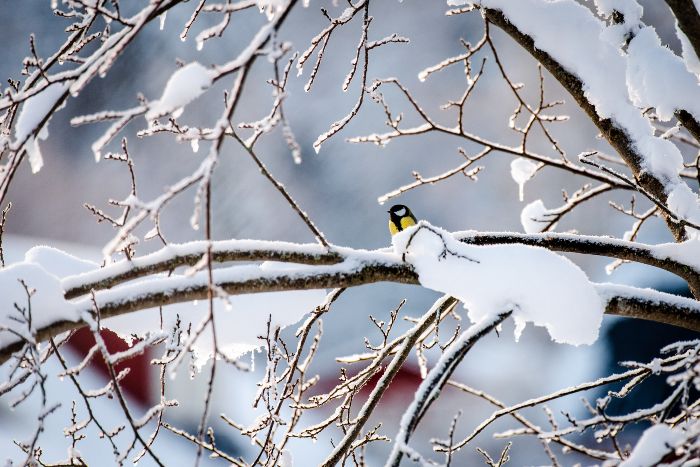Winter Tree Pruning: Good or Bad?
As winter settles in and leaves drop off, the idea of pruning your trees might seem counterintuitive. After all, the common belief is that trees should be left alone during the colder months to save energy. However, contrary to this popular notion, winter tree pruning can benefit your trees’ overall health and vitality. In this blog, we’ll discuss whether winter tree pruning is a good practice and explore five good reasons to pull out those pruning tools in the colder months!
5 Benefits of Winter Tree Pruning

Makes Tree Structure More Visible
One advantage of pruning trees during winter is a clearer view of the tree’s structure. This mainly benefits deciduous trees, as their leaves have fallen, revealing the underlying structure. Without leaves, branches are more visible, allowing arborists and homeowners to identify structural issues. Pruning can improve the tree’s overall form and reduce the risk of branch failure during storms or heavy winds by identifying weak or diseased branches.
Winter Pruning Avoids Spreading Disease
Many tree diseases are caused by bacteria, fungi, or pests that thrive in warm and humid conditions. Pruning during winter, when these pathogens are less active, can reduce the risk of spreading diseases through pruning wounds. By removing infected branches before the growing season, you can limit the disease’s spread and protect the overall health of the tree.
Better Spring Growth
Pruning in winter can stimulate better spring growth by directing the tree’s energy to the areas that need it most. When you remove dead or unnecessary branches, the tree can allocate more resources to developing new, healthy growth in the spring.
This is particularly beneficial for flowering and fruit-bearing trees. By strategically pruning during winter, you encourage the tree to produce more vibrant flowers and fruits when the growing season arrives. Proper pruning can also enhance air circulation and sunlight penetration, further promoting robust spring growth.
Increases Efficiency
Since many trees are dormant during the winter months, they are less stressed by the pruning process. This means less shock for the tree and a quicker recovery.
Additionally, winter is often a convenient time to prune due to the reduced workload compared to the busy spring and summer seasons. With fewer leaves and foliage to contend with, pruning operations become more straightforward. Homeowners and professionals alike can take advantage of this dormant period to address pruning needs without causing undue stress to the trees.
Dormant Pruning Prevents Winter Damage
As winter storms and heavy snowfall threaten trees, dormant pruning can help mitigate potential winter damage. Removing weak, dead, or overhanging branches reduces the risk of breakage under the weight of snow and ice. This proactive approach to winter tree care not only safeguards the tree’s structure but also minimizes the chances of property damage and personal injury during winter storms.
Should You Still Prune in Spring and Summer?
While winter pruning offers several advantages, tree care is a year-round commitment. Pruning in spring and summer can be necessary for specific reasons, complementing the winter pruning regimen.
Spring Pruning
Spring is a time of renewed growth and activity for trees. Pruning during this season is often focused on shaping the tree and addressing potential issues that may have become apparent as the tree starts to bud. It’s also a good time for corrective pruning, targeting branches that may have suffered from winter stress, damage, or diseases. Also, spring pruning can be ideal for fruit trees, as it allows for the removal of dead or damaged wood and the shaping of the canopy to enhance sunlight exposure.
Summer Pruning
Summer pruning focuses on maintaining the shape of the tree, controlling size, and removing any diseased or dead branches that may have emerged during the growing season. Pruning at this time is particularly beneficial for managing the overall density of the canopy. Thinning out excess growth allows for better air circulation and sunlight penetration, reducing the risk of diseases that thrive in humid environments. But it’s important to note that over pruning should be avoided, as it can stress the tree during its peak growth phase.
How to Prune Trees in the Winter

Pruning trees during winter requires a thoughtful and strategic approach. Here are some pruning tips to ensure effective winter pruning:
- Select the Right Tools:
Invest in high-quality pruning tools, including sharp bypass pruners, loppers, and a pruning saw. Clean and sharpen your tools before use to make clean cuts and minimize stress on the tree.
- Identify Dead or Diseased Wood:
Begin by identifying and removing dead, damaged, or diseased branches. This not only improves the tree’s appearance but also prevents the spread of diseases.
- Shape the Canopy:
Use winter pruning to shape the tree’s canopy and improve its overall structure. Remove any branches that cross or rub against each other and thin out crowded areas to allow for better air circulation.
- Consider the Tree’s Dormant State:
Take advantage of the tree’s dormant state to make more significant cuts without causing excessive stress. However, avoid removing too many branches or foliage, as the tree still requires some leaves for photosynthesis.
- Remove Suckers and Water Sprouts:
Eliminate any unwanted growth, such as suckers and water sprouts, as they can divert energy away from the main branches and compromise the tree’s health. Suckers and water sprouts are also weakly attached to the main branch, so they’re more likely to break as they grow and become heavier.
Schedule Your Winter Pruning?
With winter around the corner, it’s time to plan and schedule your tree pruning. Getting your trees pruned now can reduce winter storm damage, minimize disease spread, and get your trees safe and ready for the upcoming year. Contact us for a complimentary assessment or check out our Tree Pruning & Trimming Services!





